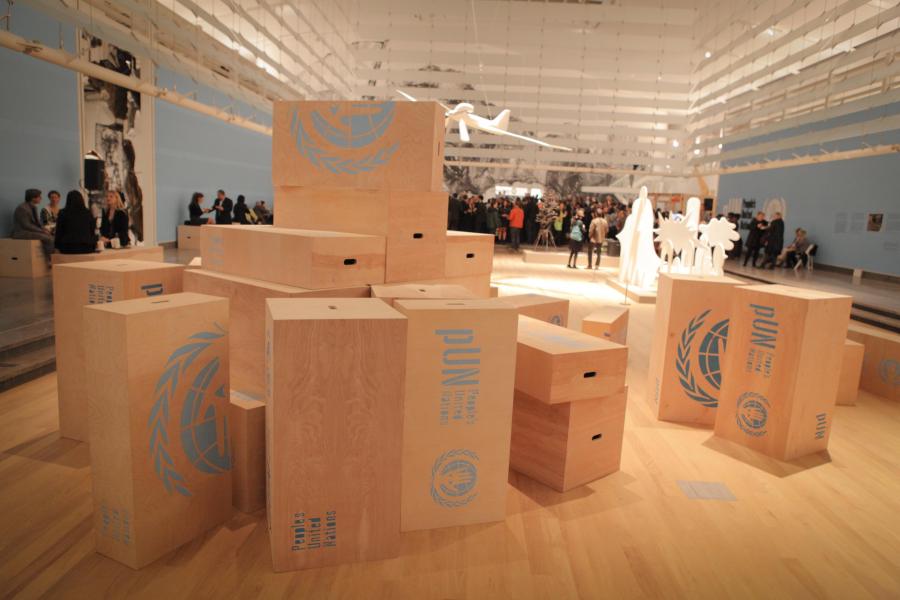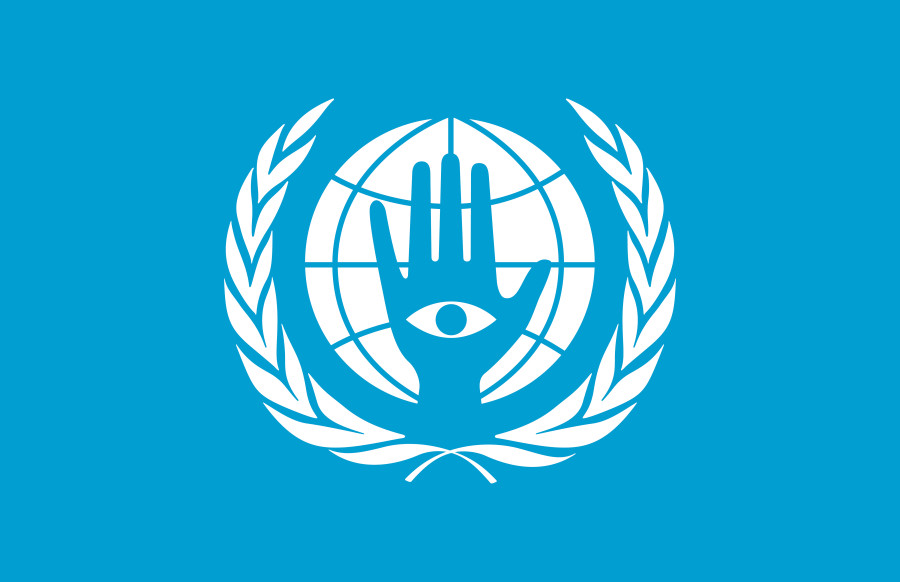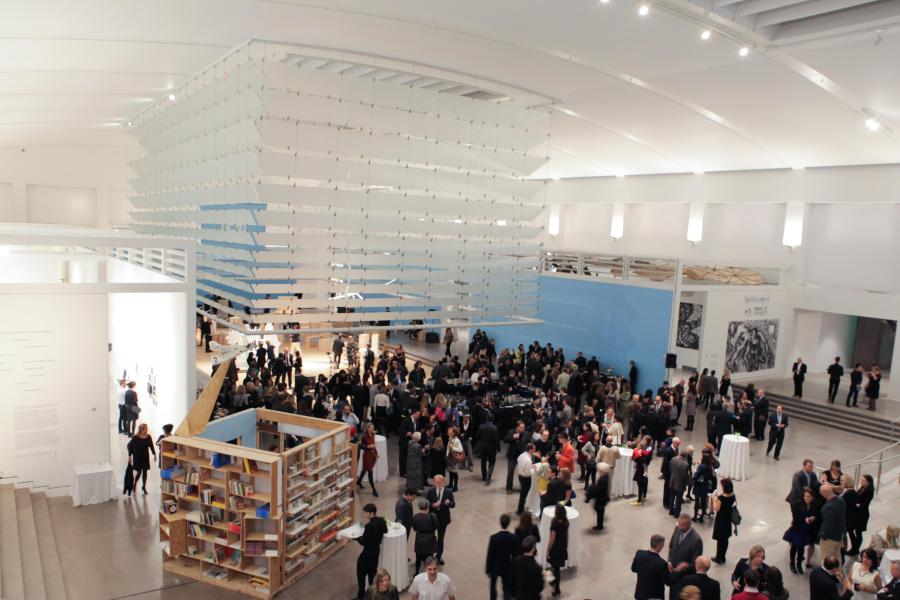Mexican artist Pedro Reyes has a thing or two to say about global diplomacy and the state of human affairs across the world.
In "The People's United Nations (pUN)," an exhibition slated to hit New York this month, the artist offers a particularly interesting call to action: If conventional diplomatic efforts have continuously failed to solve the world's most pressing problems -- environmental abuse, poverty, weapons proliferation, food scarcity -- then why not turn to conflict-resolution techniques outside the game of politics. Theater, couples therapy, vintage social science; Reyes suggests that diving into the archives of these fields will offer more insightful methods of change than the cavernous discussions of the UN today.
Like any good social science proponent, Reyes isn't just tossing a hypothesis to the wind, he's devised a way to light-heartedly test his idea. He's headed to the Queens Museum, the newly reopened institute that famously housed the General Assembly from 1946-1950. There he'll man a 193-member mock delegation, pUN, comprised of New York immigrants and their family members who will mull over and debate issues ranging from geo-engineering to gun control, all whilst seated in a the giant, and very public, space in Flushing, Queens.
We caught up with Reyes before his two-day Queens Museum event, a part of the giant performance art festival taking over New York City this November, Performa 13. Here's what the artist had to say about drones, climate change and the power of visual art:

Queens Museum, courtesy Laila Bahman
How did the idea behind pUN come about?
Well, the curator, Larissa Harris, wanted me to do a kind of project for the reopening of the museum, and I was very interested in the history of the building, which was a venue for the United Nations from '46 to 1950. And also, Queens is the part of the world that has the highest diversity per square mile.
I'm a big fan of Queens. It's where I live.
Yes, so you know! And the Queens Museum does a lot of vocational programs. They're truly a museum of the community. So there were those factors that came together and made so much sense to do this kind of summit.
Did you recruit people from Queens to participate in the delegation?
It's curious, you would think that you could find one person from every country on earth in New York, but we're struggling to find some people from, like, islands in the middle of the Pacific Ocean. Countries you've never heard of.
Which countries are those?
Oh, how about Tuvalu. Tiny island.
What was your method of reaching out to participants?
It was hybrid. The museum has itself a good network, so for instance, they had organized a program of film from Africa. With that network, they contacted a lot of filmmakers, scholars and activists from countries in Africa. Sometimes we just knew people from countries, people we knew were amazing. And we could ask them for the favor. Sometimes it was hard, because perhaps there were too many people from Mexico or Ecuador who were friends of the museum. But so far, we have 110 delegates to date, confirmed. But everyday new ones are added. It's a very unique experience. Because not even in the United Nations do you get to have representatives from each nation show up in a single session.
In a description for the exhibition, it states that “since diplomacy has not yet solved the world’s problems, conflict-resolution techniques proven in other fields should be tried instead.” What types of world problems are we talking about?
Well, for example, we're looking at climate change, and we're having a discussion about geo-engineering. Do you know about geo-engineering? It seems like the only way to stop the Arctic from melting, or sea levels from rising -- which could make New York end up under the water in 600 years -- would be to modify the reflectivity of the atmosphere. The way to do that would be to pump sulfur dioxide into the stratosphere. So, that is a polemic approach. It's the equivalent to chemotherapy, but for planet Earth. A lot of environmentalists oppose it, because it's polluting the atmosphere to create a kind of shade to diminish the greenhouse effect.
So we're bringing in an expert, who's going to lecture on the topic, and then we're going to vote [on the issue]. The decision might be something that is discussed in the next five years at the real UN. We're kind of having an advanced discussion. But there are also other things that have to do with climate change -- the food we're serving, we're going to have the world premiere of the grasshopper burger. It's like a mini burger, but instead of meat, it has grasshoppers and little crickets grilled with cheese. And it's delicious.

Pedro Reyes, The People’s United Nations (pUN) Logo, 2013
And these will be fed to the delegates?
Yes, because you know, protein from insects is the way of the future. Because producing meat has a carbon footprint, but it's also water-intensive. Water is a limited resource, so we really need to stop eating meat. Meat from hamburgers that you eat from fast food [restaurants] is really gross. And, if you compare these grasshoppers to meat, they're super kosher. So we're calling it the Grass Whopper.
[Laughs] That's a perfect name. It sounds like these types of environmental issues are important to you personally, not just as part of the pUN initiative.
Yes. I have done other projects in the past, which have to do with the environment. For example, "Palas por Pistolas," was a project where I took guns and melded them to make shovels to plant trees. It's something that I care for.
You've worked with transforming weapons into alternative objects before. Will any issues surrounding weapons and weapons proliferation be a part of the delegation?
Oh yes. There is one sculpture [I brought to the museum], called "Disarm Clock," that is a mechanical clock that every half hour or quarter of the hour, it makes a sound, made from metal parts from guns. There is also a sculpture called "Drone Dove." This of the things we want to talk about during the delegation -- weapons. With Napalm or Agent Orange or land mines -- they were used in the 20th century, but now they are banned. We are trying to have a discussion about whether drones should be banned. We're actually saying that drone attacks are terrorist attacks. That's a sort of resolution that will be voted on.
And you're going to use alternative techniques for diplomacy -- theater games, group therapy, and techniques from social science -- to talk about things like climate change and weapons?
There is one technique called "Theater of the Oppressed." It is used worldwide for conflict resolution. It was invented by Augusto Boal, a Brazilian director in the '60s. It is used for AIDS prevention in Africa or gender equity conversations in India. And everywhere! We're also using another technique called "Forcefield Analysis." It is a social science technique invented by Kurt Lewin. But there are other activities that are very playful. We're going to have a therapist there, who is kind of a couples coach. So two countries that have had a long-standing hatred are invited to receive this therapy.

Pedro Reyes, Colloquium, 2013. Laminate marble, Courtesy: Lisson Gallery.
What type of research went into determining these techniques? It seems like they would be methods used in some distant Utopian future.
I've done a lot of workshops in vocational environments and museums, and I have learned these techniques. But they are techniques that have been around for a while. They're not new. Forcefield Analysis was created in the 1940s. Nevertheless, we are taking a science fiction approach. We're time-traveling to the present. We are somehow trying to do these workshops so that every single person is engaged. It's not the type of lecture where one person is speaking and everyone else is listening. Here we have a sort of speed dating structure. Where there is a group of delegates that meet, the bell rings and then they have to go onto the next table. Each table has an issue and it is reviewed and discussed by a small group.
What will be the role of the viewer in this performance?
For the summit, they are more like spectators. There is a tour, so they will be shown around, because there will be a lot of readings and material to see. There will be sculptures and paintings and infographics. But [the viewer] can see all the activities of the summit as they happen. All the delegates are kind of on stage, so to speak, having these kinds of debates, and the viewer can learn about what they are discussing depending on what moment of the day they decide to attend. There is also going to be an exhibition. After November 23 and 24 [the dates of the performance], all the outcomes from the activities will be on display.
So you have a melding of this physical exhibition and the actual performance. From an artist's perspective, what do you think the performance aspect of the project is achieving that a physical exhibition could not?
The performative aspect starts with the presence of one person from every country on Earth. That's a kind of concept in itself, to try and do a global gathering or global encounter. But it's important that these activities actually happen. These are techniques that come from different sources -- you have psychology, theater, games, food. It's a little bit like a festival, if you want. It's very playful, but very serious, and that's the kind of ambiguity we want. And that's precisely why it's called pUN. You have these two ideas to interpret. A thin line between being serious and doing pranks. I believe that pranks and jokes are the most efficient way to deliver content. When someone wants to tell you a shocking fact, it's often easier for you to take in that information in the shape of jokes. You could get the same information watching both "Democracy Now" and "The Daily Show." But perhaps it's easier to watch "The Daily Show"? Both are great, but jokes are a good delivery system for content.
Which is sort of the same benefit of science fiction -- using sci-fi tropes as a vehicle for delivering fact.
Of course, Science Fiction is another resource we use to raise awareness of the immanence of these issues.
What do you think is hindering the UN's ability to actually solve problems?
One of the main differences between pUN and the UN is that delegates at the UN represent their government. And governments have an agenda which is first, their national interest; second, the interest of the their people; and third, the interest of the planet. In pUN, I think that the delegates are not concerned with representing their governments -- they represent their nation-states, their people. It's not the usual agenda. So they can take a stand with having a more global perspective.
But I don't think pUN is in itself a critique of the UN. It's more about the idea of making a crash course on conflict resolution. It's like a tool kit. And the hope is that those who attend the summit learn techniques and learn about issues that affect us all. It's a very intensive educational experience, but it's also fun, no?

Queens Museum, courtesy Laila Bahman
"Pedro Reyes: The People's United Nations (pUN)" will happen on November 23-24, 2013, beginning at 12pm each day at the Queens Museum. The exhibition will be on view from November 9, 2013-March 30, 2014.
The newly renovated Queens Museum officially opened to the public on November 9.